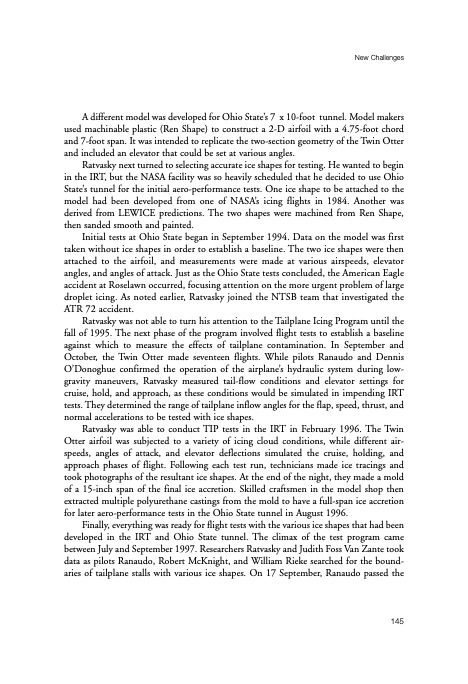
PDF Publication Title:
Text from PDF Page: 156
A different model was developed for Ohio State’s 7 x 10-foot tunnel. Model makers used machinable plastic (Ren Shape) to construct a 2-D airfoil with a 4.75-foot chord and 7-foot span. It was intended to replicate the two-section geometry of the Twin Otter and included an elevator that could be set at various angles. Ratvasky next turned to selecting accurate ice shapes for testing. He wanted to begin in the IRT, but the NASA facility was so heavily scheduled that he decided to use Ohio State’s tunnel for the initial aero-performance tests. One ice shape to be attached to the model had been developed from one of NASA’s icing flights in 1984. Another was derived from LEWICE predictions. The two shapes were machined from Ren Shape, then sanded smooth and painted. Initial tests at Ohio State began in September 1994. Data on the model was first taken without ice shapes in order to establish a baseline. The two ice shapes were then attached to the airfoil, and measurements were made at various airspeeds, elevator angles, and angles of attack. Just as the Ohio State tests concluded, the American Eagle accident at Roselawn occurred, focusing attention on the more urgent problem of large droplet icing. As noted earlier, Ratvasky joined the NTSB team that investigated the ATR 72 accident. Ratvasky was not able to turn his attention to the Tailplane Icing Program until the fall of 1995. The next phase of the program involved flight tests to establish a baseline against which to measure the effects of tailplane contamination. In September and October, the Twin Otter made seventeen flights. While pilots Ranaudo and Dennis O’Donoghue confirmed the operation of the airplane’s hydraulic system during low- gravity maneuvers, Ratvasky measured tail-flow conditions and elevator settings for cruise, hold, and approach, as these conditions would be simulated in impending IRT tests. They determined the range of tailplane inflow angles for the flap, speed, thrust, and normal accelerations to be tested with ice shapes. Ratvasky was able to conduct TIP tests in the IRT in February 1996. The Twin Otter airfoil was subjected to a variety of icing cloud conditions, while different air- speeds, angles of attack, and elevator deflections simulated the cruise, holding, and approach phases of flight. Following each test run, technicians made ice tracings and took photographs of the resultant ice shapes. At the end of the night, they made a mold of a 15-inch span of the final ice accretion. Skilled craftsmen in the model shop then extracted multiple polyurethane castings from the mold to have a full-span ice accretion for later aero-performance tests in the Ohio State tunnel in August 1996. Finally, everything was ready for flight tests with the various ice shapes that had been developed in the IRT and Ohio State tunnel. The climax of the test program came between July and September 1997. Researchers Ratvasky and Judith Foss Van Zante took data as pilots Ranaudo, Robert McKnight, and William Rieke searched for the bound- aries of tailplane stalls with various ice shapes. On 17 September, Ranaudo passed the New Challenges 145PDF Image | History of NASA Icing Research Tunnel

PDF Search Title:
History of NASA Icing Research TunnelOriginal File Name Searched:
sp4226.pdfDIY PDF Search: Google It | Yahoo | Bing
NFT (Non Fungible Token): Buy our tech, design, development or system NFT and become part of our tech NFT network... More Info
IT XR Project Redstone NFT Available for Sale: NFT for high tech turbine design with one part 3D printed counter-rotating energy turbine. Be part of the future with this NFT. Can be bought and sold but only one design NFT exists. Royalties go to the developer (Infinity) to keep enhancing design and applications... More Info
Infinity Turbine IT XR Project Redstone Design: NFT for sale... NFT for high tech turbine design with one part 3D printed counter-rotating energy turbine. Includes all rights to this turbine design, including license for Fluid Handling Block I and II for the turbine assembly and housing. The NFT includes the blueprints (cad/cam), revenue streams, and all future development of the IT XR Project Redstone... More Info
Infinity Turbine ROT Radial Outflow Turbine 24 Design and Worldwide Rights: NFT for sale... NFT for the ROT 24 energy turbine. Be part of the future with this NFT. This design can be bought and sold but only one design NFT exists. You may manufacture the unit, or get the revenues from its sale from Infinity Turbine. Royalties go to the developer (Infinity) to keep enhancing design and applications... More Info
Infinity Supercritical CO2 10 Liter Extractor Design and Worldwide Rights: The Infinity Supercritical 10L CO2 extractor is for botanical oil extraction, which is rich in terpenes and can produce shelf ready full spectrum oil. With over 5 years of development, this industry leader mature extractor machine has been sold since 2015 and is part of many profitable businesses. The process can also be used for electrowinning, e-waste recycling, and lithium battery recycling, gold mining electronic wastes, precious metals. CO2 can also be used in a reverse fuel cell with nafion to make a gas-to-liquids fuel, such as methanol, ethanol and butanol or ethylene. Supercritical CO2 has also been used for treating nafion to make it more effective catalyst. This NFT is for the purchase of worldwide rights which includes the design. More Info
NFT (Non Fungible Token): Buy our tech, design, development or system NFT and become part of our tech NFT network... More Info
Infinity Turbine Products: Special for this month, any plans are $10,000 for complete Cad/Cam blueprints. License is for one build. Try before you buy a production license. May pay by Bitcoin or other Crypto. Products Page... More Info
| CONTACT TEL: 608-238-6001 Email: greg@infinityturbine.com | RSS | AMP |